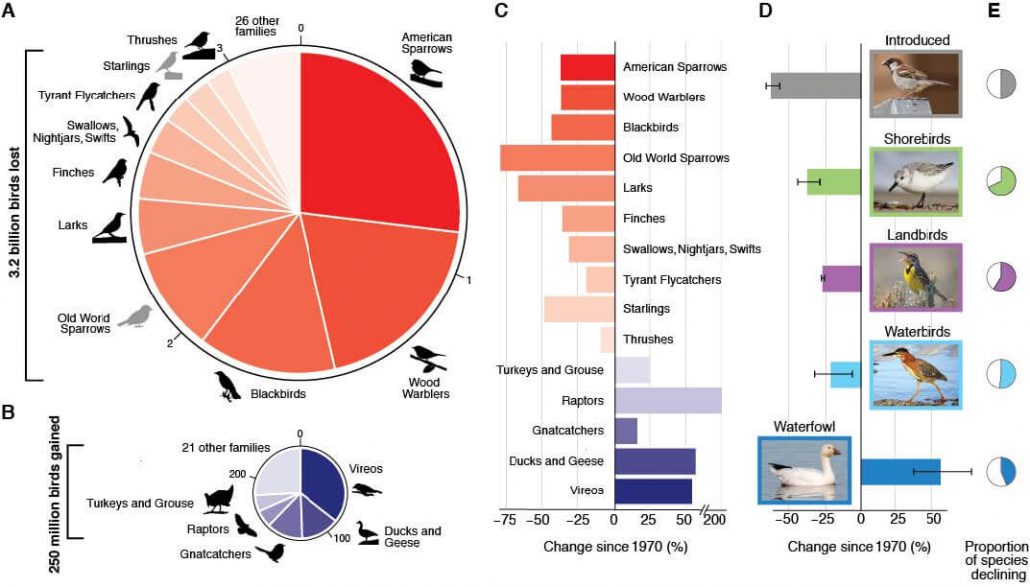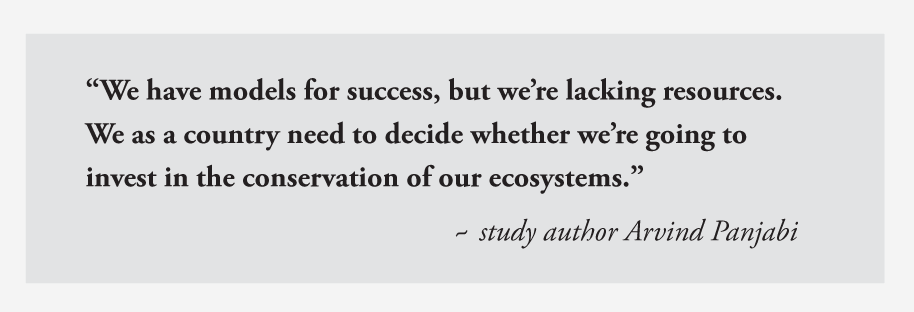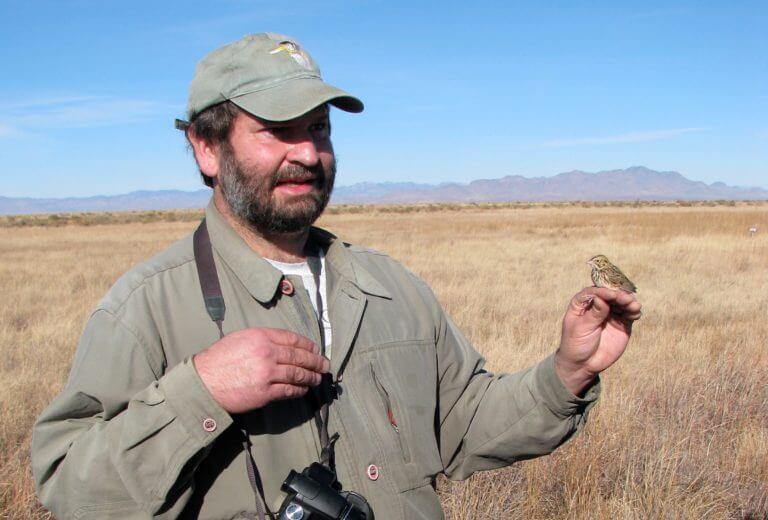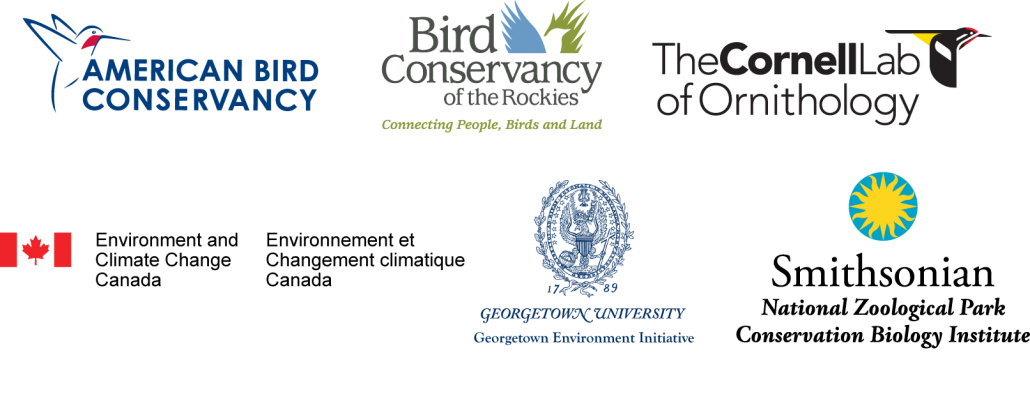[vc_row type=”in_container” full_screen_row_position=”middle” scene_position=”center” text_color=”dark” text_align=”left” overlay_strength=”0.3″][vc_column column_padding=”no-extra-padding” column_padding_position=”all” background_color_opacity=”1″ background_hover_color_opacity=”1″ width=”1/1″ tablet_text_alignment=”default” phone_text_alignment=”default”][vc_column_text]
1 in 4 birds lost
New findings just published in the journal Science confirm staggering losses among birds. Based on nearly 50 years of data collected and studied by multiple organizations including Bird Conservancy of the Rockies, this research for the first time quantifies the severity of avian population declines across North America.
There are roughly 3 billion fewer birds in the U.S. and Canada today than in 1970.
An estimated 29 percent, almost 1/3, of North America’s birds have been lost, signaling a widespread ecological crisis. The losses include diverse groups of birds and habitats and a majority of species—from iconic songsters like meadowlarks, to long-distance migrants such as swallows, and backyard favorites like sparrows and warblers. Grassland birds are especially hard hit, with a 53% reduction in population—more than 700 million birds—since 1970. Migratory birds face distinct challenges as their habitats on the breeding and wintering grounds, as well as resting spots in-between, are disappearing. Among the hardest hit biomes are grasslands, montane forests and aridlands.
Declines not limited to rare and threatened species.
History shows how quickly a species can slide toward extinction. Many birds we consider ‘common’ today are declining and at risk. The Passenger Pigeon was once likely the most numerous bird on the planet, but they disappeared in a matter of a few decades largely due to overhunting. By the time anyone realized they were almost gone, it was too late. Today, systematic monitoring of birds provides us with early warning signals. Informed by science and empowered with a modern environmental stewardship ethic, there is good reason to hope that the birds we love will not meet the same fate as the Passenger Pigeon. There is still time to make a difference![/vc_column_text][/vc_column][/vc_row][vc_row type=”in_container” full_screen_row_position=”middle” scene_position=”center” text_color=”dark” text_align=”left” overlay_strength=”0.3″][vc_column column_padding=”no-extra-padding” column_padding_position=”all” background_color_opacity=”1″ background_hover_color_opacity=”1″ width=”1/1″ tablet_text_alignment=”default” phone_text_alignment=”default”][vc_gallery type=”flexslider_style” images=”15735,15734,15560,15562,15572,15571,15574″ onclick=”link_no”][/vc_column][/vc_row][vc_row type=”in_container” full_screen_row_position=”middle” scene_position=”center” text_color=”dark” text_align=”left” overlay_strength=”0.3″][vc_column column_padding=”no-extra-padding” column_padding_position=”all” background_color_opacity=”1″ background_hover_color_opacity=”1″ width=”1/1″ tablet_text_alignment=”default” phone_text_alignment=”default”][vc_column_text]
.
About the study
This research highlights a long-developing but overlooked biodiversity crisis in North America. The study compiled stats from 14 bird-monitoring datasets, some of which provide close to fifty years of monitoring information. Data sources include the Partners in Flight Avian Conservation Assessment Database (ACAD), North American Breeding Bird Survey (BBS), U.S. Geological Survey, Canadian Wildlife Service and Audubon’s annual Christmas BirdCount (CBC). Further evidence came from the detection of migratory birds in the air from 143 NEXRAD weather radar stations across the continental U.S. over the past decade. North American bird species in the continental United States and Canada were evaluated for population change and status trends. Researchers integrated range-wide estimates of population size and 48-year population trajectories to quantify net change in numbers of birds across the avifauna over recent decades.
[/vc_column_text][/vc_column][/vc_row][vc_row type=”in_container” full_screen_row_position=”middle” scene_position=”center” text_color=”dark” text_align=”left” overlay_strength=”0.3″][vc_column column_padding=”no-extra-padding” column_padding_position=”all” background_color_opacity=”1″ background_hover_color_opacity=”1″ width=”1/1″ tablet_text_alignment=”default” phone_text_alignment=”default”][vc_column_text]
What’s causing the declines?
Habitat loss is the biggest overall driver of bird declines. When habitat disappears, all the birds that live there lose their homes. Habitat loss occurs when land is converted for agriculture, development, resource extraction, and other uses. Habitat degradation is a second cause of losses. In this case, habitat doesn’t disappear outright but becomes less able to support birds, such as when habitat is fragmented, altered by invasive plants, or when water quality is compromised.
Reasons for hope
Highlighting conservation successes.
Even while these widespread declines were happening, some bird groups have made rapid turnarounds—proving that concerted action can bring birds back. Early legislation, like the Migratory Bird Treaty enacted in 1916, provides protections for birds and promotes recovery of once-depleted bird species. Raptors such as the Bald Eagle and Osprey have made spectacular comebacks since the 1970s after the harmful pesticide DDT was banned and recovery efforts in the United States and Canada provided critical safeguards. In 2007, the Bald Eagle was removed from the List of Threatened and Endangered Species and is considered one of conservation’s greatest success stories.

Waterfowl (ducks, geese, and swans) have seen a net gain of 30 million birds over the past 50 years. This remarkable recovery has been made possible through conservation investments by hunters and government funding for wetland protection and restoration. Woodpeckers are a resilient group of birds that demonstrate certain species can adapt to humans and urban areas, if only some habitat (such as forested backyards) can be left available for them. Habitat improvements for individual species, such as sage-grouse, often provide benefits for many others. Farm Bill working lands conservation programs focusing on Lesser Prairie-Chicken were shown to also help grassland birds that share similar habitat. And best of all, the efforts also benefit people and improve our own quality of life—the water we drink, the food we eat, and the beauty of natural landscapes that we enjoy.[/vc_column_text][/vc_column][/vc_row][vc_row type=”in_container” full_screen_row_position=”middle” scene_position=”center” text_color=”dark” text_align=”left” overlay_strength=”0.3″][vc_column column_padding=”no-extra-padding” column_padding_position=”all” background_color_opacity=”1″ background_hover_color_opacity=”1″ width=”1/1″ tablet_text_alignment=”default” phone_text_alignment=”default”][vc_gallery type=”flexslider_style” images=”15576,15577,15580,15582,15600″ onclick=”link_no”][/vc_column][/vc_row][vc_row type=”in_container” full_screen_row_position=”middle” scene_position=”center” text_color=”dark” text_align=”left” overlay_strength=”0.3″][vc_column column_padding=”no-extra-padding” column_padding_position=”all” background_color_opacity=”1″ background_hover_color_opacity=”1″ width=”1/1″ tablet_text_alignment=”default” phone_text_alignment=”default”][vc_column_text]
Science to solutions
Bird Conservancy of the Rockies is building on discoveries that our research and monitoring programs have revealed. More than a decade of data on wintering and breeding grassland birds are being used to create an integrated population model to identify the leading causes of population declines. Innovative, collaborative approaches are pinpointing where conservation is needed most, and guiding work on the ground for maximum impact.
An estimated 65-70% of prime bird habitat in North America is on private lands, demonstrating the importance of helping land owners and managers integrate conservation into management practices. Central and western Canada, Mexico and the U.S. account for a vast majority of North America’s grasslands, aridlands and western forests. Bird Conservancy has extended its network of private lands biologists and partnerships from Canada to Mexico to ensure rangeland remains healthy for people and birds. State and federal agencies, NGOs, landowners, industry, agricultural producers and individuals are joining forces to ensure a viable interconnected landscape that supports healthy flocks of grassland birds, seas of grasses and grains, successful businesses, thriving ranches and farms, and healthy habitat for people and wildlife.[/vc_column_text][/vc_column][/vc_row][vc_row type=”in_container” full_screen_row_position=”middle” scene_position=”center” text_color=”dark” text_align=”left” overlay_strength=”0.3″][vc_column column_padding=”no-extra-padding” column_padding_position=”all” background_color_opacity=”1″ background_hover_color_opacity=”1″ width=”1/1″ tablet_text_alignment=”default” phone_text_alignment=”default”][vc_column_text]
 Take action!
Take action!
Birds are telling us we must act now to ensure our planet can sustain wildlife and people. Our everyday choices can help conserve millions of birds. Ways to get involved:
- Check out these “Seven Simple Actions to Save Birds”
- Visit our Live Bird Friendly page for ideas on how to make your home and garden safe havens for birds
- Help spread the word! Click the #BringBirdsBack website for shareable infographics, links, and videos
- Make your voice heard in relation to important conservation legislation, such as the Recovering America’s Wildlife Act.
Your contributions make conservation possible. Will you act now with a gift of support to help bring them back and keep them abundant, forever gracing our skies?

ABOUT THE CO-AUTHOR
Dr. Arvind Panjabi is Avian Conservation Scientist at Bird Conservancy of the Rockies and one of the co-authors of this scientific research. Dr. Panjabi is an expert in grassland and aridlands migratory birds, with emphasis on species that migrate between Northern Mexico (Chihuahua) and the Northern Great Plains. He is a key player in the development and implementation of monitoring programs aimed at these species. He works closely with Partners in Flight, manages the PIF Species Assessment Database, and was instrumental in applying the PIF assessment process to the Mexican avifauna, in conjunction with federal and NGO partners in Mexico. Dr. Panjabi has also been involved in species assessment coalition efforts across wider Central America. He is an AMAZING birder (both by ear and sight) and loves to share their stories with anyone that will listen! Dr. Panjabi can be reached via e-mail or phone: (970) 482-1707 x20. Above photo courtesy of Sonoran Joint Venture.
ABOUT THE STUDY
Citation: Rosenberg, K. V. et al. 2019. Decline of the North American Avifauna. Science 365(6461). doi: 10.1126/science.aaw1313
Contributors: Cornell Lab of Ornithology, American Bird Conservancy, U.S. Geological Survey, Bird Conservatory of the Rockies, Smithsonian Migratory Bird Center, Georgetown University.
Data were contributed by citizen-science participants in the Audubon Christmas Bird Count, Breeding Bird Survey, and other bird-monitoring initiatives. The Partners in Flight Avian Conservation Assessment Database was a critical source for the data.
Click here to download a press release.
We’re united to create better protections and support for birds. Join us!
 [/vc_column_text][/vc_column][/vc_row][vc_row type=”in_container” full_screen_row_position=”middle” scene_position=”center” text_color=”dark” text_align=”left” overlay_strength=”0.3″][vc_column column_padding=”no-extra-padding” column_padding_position=”all” background_color_opacity=”1″ background_hover_color_opacity=”1″ width=”1/1″ tablet_text_alignment=”default” phone_text_alignment=”default”][vc_column_text]
[/vc_column_text][/vc_column][/vc_row][vc_row type=”in_container” full_screen_row_position=”middle” scene_position=”center” text_color=”dark” text_align=”left” overlay_strength=”0.3″][vc_column column_padding=”no-extra-padding” column_padding_position=”all” background_color_opacity=”1″ background_hover_color_opacity=”1″ width=”1/1″ tablet_text_alignment=”default” phone_text_alignment=”default”][vc_column_text]
[/vc_column_text][/vc_column][/vc_row]











